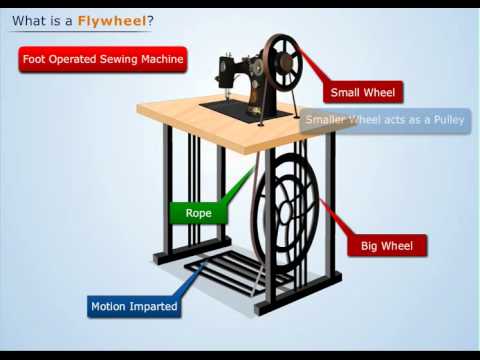 |
| Working of Flywheel | Theory of Machines |
A flywheel is a mechanical device specifically designed to efficiently store rotational energy (kinetic energy), which is proportional to the square of its rotational speed and its mass. Flywheels resist changes in rotational speed by their moment of inertia and in order to change a flywheel's stored energy (without changing its mass) its rotational speed must be increased or decreased. Since flywheels act as mechanical energy storage devices, they are the kinetic-energy-storage analogue to electrical inductors, for example, which are a type of accumulator.
Like other types of accumulators, flywheels smooth the ripple in power output, providing surges of high power output as required, absorbing surges of high power input (system-generated power) as required, and in this way act as low-pass filters on the mechanical velocity (angular, or otherwise) of the system.
Common uses of a flywheel include: Smoothing the power output of an energy source. For example, flywheels are used in reciprocating engines because the active torque from the individual pistons is intermittent. Energy storage systems Delivering energy at rates beyond the ability of an energy source.
This is achieved by collecting energy in a flywheel over time and then releasing it quickly, at rates that exceed the abilities of the energy source. Controlling the orientation of a mechanical system, gyroscope and reaction wheel
Common uses of a flywheel include: Smoothing the power output of an energy source. For example, flywheels are used in reciprocating engines because the active torque from the individual pistons is intermittent. Energy storage systems Delivering energy at rates beyond the ability of an energy source.
This is achieved by collecting energy in a flywheel over time and then releasing it quickly, at rates that exceed the abilities of the energy source. Controlling the orientation of a mechanical system, gyroscope and reaction wheel
- Flywheels are typically made of steel and rotate on conventional bearings; these are generally limited to a maximum revolution rate of a few thousand RPM.
- High energy density flywheels can be made of carbon fiber composites and employ magnetic bearings, enabling them to revolve at speeds up to 60,000 RPM (1 kHz).
- Carbon-composite flywheel batteries have recently been manufactured and are proving to be viable in real-world tests on mainstream cars. Additionally, their disposal is more eco-friendly than traditional lithium ion batteries.[3]
This video explains the whole concept of Flywheel with the help of a sewing machine as an example. The topic of learning is a part of the Theory of Machines-I course. The course also covers the Kinematic Analysis of Mechanisms like Automobile Steering, Belt Drives, Cam-Followers, Flywheel, Governors, and Brakes etc.
Related Topics:

Post a Comment